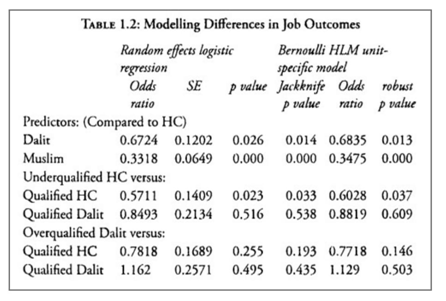Preeti Chandrakumar Patil
Sukhadeo Thorat and Katherine Newman in their article ‘Caste and Economic Discrimination: Causes, Consequences and Remedies’ have defined Social Exclusion as a process by which certain groups are denied full or partial access to the economic, educational, and social institutions that determine social membership. Exclusion in India is defined by systems that discriminate against, isolate, shame, and deprive subordinate groups based on identities such as caste, religion, and gender. Caste system’s fundamental characteristics of ascribing specific occupations to specific groups itself is exclusion and restriction for one caste in taking up the ascribed occupation of the other caste, thus making this economic exclusion very internal to the system on the one hand while it is also its necessary outcome on the other hand. Fixed economic rights defined on caste lines with rigid resistance to change leads to forced exclusion of groups that lie lower in the hierarchy.
In terms of market economies, immobility of labour and capital under caste division translates into segmented and imperfectly mobile markets which eventually affects the efficiency of such caste driven models as compared to the perfectly competitive market models. The consequences of such economic discrimination are grave. They result in lower economic growth, income inequalities, and poverty. The restrictions on mobility of labour cause involuntary unemployment for the lower castes whereas voluntary unemployment for the upper castes as they find certain occupations to be polluting. Caste as a form of economic organization is built on the lines of restrictions and hence cause inter-group conflict and hence leads human resources to destructive ends. Here in this article, I have tried to analyse how there is economic exclusion on caste lines in the Indian private sector. I have also presented an account of how other countries in the world have developed policy mechanisms to deal with economic exclusion of their minority groups and tried to critically analyse the policy directions that have appeared in Indian context. I have mostly based my study on the work of Sukhadeo Thorat and Katherine Newman’s book ‘Blocked by Caste’ but also included insights from the works of S. Madheswaran and Surinder S. Jodhka.
Affirmative action policies have long been used in the private and public sectors in other countries, but in India, the privatization process, combined with the state’s withdrawal from many spheres under the liberalization regime, has further narrowed and compressed the little space that the discriminated groups had gained up to that point. The Indian corporate sector refuses to acknowledge that caste or community discrimination may exist in the Indian labour market. It claims that the private sector does not take caste identities into account in employment. It further asserts that based on the scant data available, a large number of Scheduled Castes and Scheduled Tribes are already employed in the commercial sector. Employer prejudice, according to Dalit groups, continues to hinder low-caste applicants from gaining entry to all but the lowest-level positions in the modern private sector.
Scholars like Jodhka and Newman have discovered that a candidate’s fitness is rarely determined just by his or her official qualifications. Almost every hiring manager interviewed agreed that one of the most essential questions they ask during interviews is about the candidate’s family background. The candidate’s compatibility to the company’s culture was determined by his or her family background. The candidate’s linguistic skills, or their ability to speak and communicate in strong English are an equally crucial criterion in hiring at the senior level. In their study of job discrimination in the private sector, Thorat and Attewell present the findings of a field experiment that found that low caste and Muslim applicants who are equally or better qualified than high caste applicants are significantly less likely to pass hiring screens among employers in India’s modern, formal sector. Only entry-level or near-entry-level positions were chosen for this study. Securities and investment firms, pharmaceutical and medical sales firms, computer sales, support, and IT services firms, various manufacturing firms, accounting firms, automobile sales and financing firms, marketing and mass media firms, veterinary and agricultural sales firms, construction firms, and banking firms were among the targeted companies. They applied for the same position with three identically qualified candidates: one Dalit, one HC Hindu, and one Muslim. However, for positions asking higher degrees they added a discordant of under-qualified HC and for positions asking for Bachelor’s degree they added a discordant of over-qualified Dalit. The findings of the study are given below.

The table shows that appropriately competent candidates with a Dalit name had 0.67 times the chance of a favourable outcome as an equivalently qualified applicant with a HC Hindu name. Applicants with a Muslim name had 0.33 times the chance of an equally equivalent application with an HC name. The estimated effects are very similar to those from the first model’s random effects logistic regression. The probability of a good outcome for an under-qualified HC candidate asking for a higher-level job was statistically considerably lower than the probability of a positive outcome for an HC applicant with the proper qualifications. The chances of an under-qualified HC application succeeding were not significantly different from the chances of a suitably qualified applicant succeeding. Although having an HC name increases a job candidate’s chances of success, if the applicant lacks the required credentials, his chances of success are greatly diminished. The chances of a favourable outcome for an overqualified Dalit applicant (a Dalit with an M.A. looking for employment that only required a B.A.) were higher than for a qualified Dalit, but lower than for a B.A. qualified HC candidate.
When applying by mail for jobs in the modern private-enterprise sector, our study discovered a statistically significant tendency in which college-educated lower-caste and Muslim job seekers do worse than equivalently qualified applicants with HC names. Despite the fact that the only part of the applicant’s familial origin that was communicated in these forms was the applicant’s name, this was enough to elicit a different pattern of responses to Muslim and Dalit applications compared to HC Hindu applications. Even though these were all well-educated and suitably qualified applicants wanting to enter the modern private sector, caste and religion played a role in determining job opportunities.
Several countries have used different methods to check on the economic exclusion of their minority groups. Analyzing various studies three measures have been developed in doing so:
- Legal protection against discrimination in the form of equal opportunity laws.
- Affirmative action to ensure fair participation of discriminated groups in employment.
- Reparation to compensate for the denial of property rights, denial of access to education and employment and injustices of the past.
However, in India only two policy directions emerged, one of economic empowerment directed to improving ownership of assets, capital for business, skill development and education etc., and the other one is affirmative action through reservation policies but this is the case only in public sector. This is unlike other countries, particularly USA and Malaysia, where they have extended affirmative action to private sector too. Also a problem with Indian policy is that it views economic empowerment as reparation and draws no distinction between the two. However, countries like Malaysia and USA have reparation policies in place like providing the discriminated groups with special land rights.
It is not possible to determine the employment composition of private sector enterprises in India, because corporations are not obliged to report the caste and religious composition of their workforces to the government. As a result, there is no protection against economic discrimination in the private sector. Due to the public sector’s continued contraction, there is an increasing desire for some form of affirmative action policy in the private sector. The concept of merit, as articulated in regard to caste and reservation in India, works directly against them. As a result, even after completing their schooling, Dalit candidates find it difficult to get suitable work in the private sector. Because of the widespread prejudice towards Dalits among corporate employers, Dalit candidates tend to avoid disclosing their status as a member of the reserved category. The fact that they are SC or ST is always interpreted negatively by the employer. The corporate sector must recognize caste in order to remove prejudice and the discriminatory practices that arise. Denying that caste exists would only serve to maintain the current quo. The Indian corporate sector can only move beyond tokenism and superficial CSR programmes that they proudly display for wider respectability if this reality of caste is recognized.
Equal opportunity legislation and affirmative action through reservations are two methods that can be applied based on international experience. However, where the equal opportunity method is perceived as gaining consensus within the commercial sector, reservation rules are greeted with opposition. Equal opportunity laws, in terms of legal safeguards, must be supplemented by more positive and affirmative action to improve Dalit access and participation in employment as well as other spheres such as agriculture, land markets, capital markets, producer and consumer goods markets, and social services such as education, housing, and so on. However, in Indian private sector this is far from being acknowledged. The blame of less employability of Dalits in private sector is shifted to poor education and skill development. However, the reality is that caste plays a crucial role in private sector hiring though disguised under the elements like family background and linguistic or soft skills of the candidate. Also, there is favouritism when hiring takes place through internal recommendations where employer seeks to hire candidates influenced by social relations and caste or community lines which further reduces the scope for Dalits in employment.
Thus the denial of private sector to address caste is just another way of preserving the status quo and caste privileges which further leads to more marginalization of Dalits.
~
References
- 1. Thorat, Sukhadeo, and Paul Attewell. “The Legacy of Social Exclusion: A Correspondence Study of Job Discrimination in India.” Economic and Political Weekly, vol. 42, no. 41, 2007, pp. 4141–45. JSTOR, http://www.jstor.org/stable/40276548. Accessed 8 Jun. 2022.
- Thorat, Sukhadeo. “On Reservation Policy for Private Sector.” Economic and Political Weekly, vol. 39, no. 25, 2004, pp. 2560–63. JST.OR, http://www.jstor.org/stable/4415165. Accessed 8 Jun. 2022.
- Madheswaran, S. “Is Affirmative Action Policy for Private Sector Necessary?” Indian Journal of Industrial Relations, vol. 44, no. 2, 2008, pp. 164–84. JSTOR, http://www.jstor.org/stable/27768187. Accessed 8 Jun. 2022.
- Thorat, Sukhadeo, and Katherine S. Newman. “Caste and Economic Discrimination: Causes, Consequences and Remedies.” Economic and Political Weekly, vol. 42, no. 41, 2007, pp. 4121–24. JSTOR, http://www.jstor.org/stable/40276545. Accessed 8 Jun. 2022.
- Jodhka, Surinder S. “Caste & the Corporate Sector.” Indian Journal of Industrial Relations, vol. 44, no. 2, 2008, pp. 185–93. JSTOR, http://www.jstor.org/stable/27768188. Accessed 8 Jun. 2022
~~~
Preeti Chandrakumar Patil has done her MA in Politics with Specialization in International Studies, from Jawaharlal Nehru University, New Delhi.










